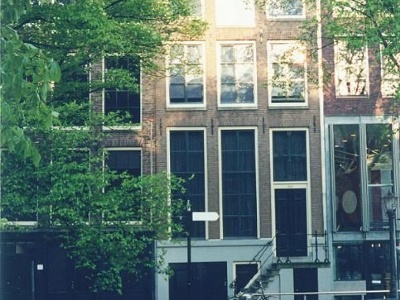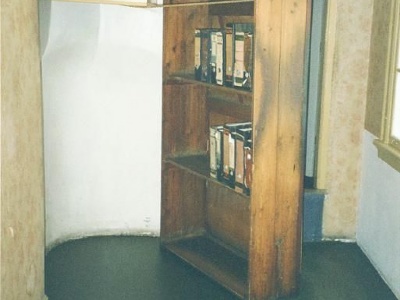Prinsengracht 263
It was at Prinsengracht 263 in Amsterdam Anne Frank and her family were hiding when they were betrayed in August 1944. Anne Frank was born in June 1929 as the second child of the marriage of Otto and Edith Frank. The couple was Jewish and had married in 1925 and their first daughter, Margot, was born in 1926. The family lived in Frankfurt and Otto was a patriarch of his time and worked as a businessman. Of the two sisters, Anne was lively and spontaneous, while Margot was calm and relaxed. The Jewish background of the family was more of a secular nature and they were well integrated into German society.
When Hitler came to power in 1933, Otto realized that it was dangerous to remain in Germany and began to prepare to leave the country. The choice fell on Amsterdam because of its proximity to Germany. Otto hoped that the anti-Semitism that followed Hitler was temporary and it would be possible to return when things had cooled down. Otto moved to Amsterdam in 1933, while the rest of the family moved in 1934.
In Amsterdam, Otto resumed his business and began to make contacts and the rest of the family assimilated into Dutch society. Both Anne and Margot went to school and socialized with Dutch friends. Other German Jewish emigrants were also part of the Frank family’s social circle. Anne and Margot became more and more Dutch and spoke Dutch rather than German. However, they kept in touch with both family and friends who had stayed in Germany.
Until the outbreak of war, Jewish emigrants lived without danger, but when Holland was occupied by the germans in may 1940, the situation changed. Initially, the Jews in Holland did not risk being deported, but they were forced to submit to anti-Jewish laws and regulations. For a while Otto thought about emigrating again but chose to stay because he told himself that it would not be worse than it was. The family had also taken root in Amsterdam and to start again elsewhere was deemed too exhausting. But slowly the noose on the Dutch jews tightened and in april 1942 they were forced to wear a yellow star of David when they were outdoors.
At the beginning of July 1942 Margot was called up to work in Germany and Otto thought it was time to hide. Otto had prepared a hiding place at his company on Prinsengracht 263 where the family moved in the same day as the call-in order came. A week later, the Pels family also moved into the hideout and in November another person, Fritz Pfeffer, arrived at the hideout. A total of eight people lived in what came to be called the farm house.
As a birthday present the same year, Anne had received a diary in which she could write about everything between heaven and earth. The diary is much more comprehensive, analytical and well-written than you would expect from a thirteen-year-old. She is also aware of what is happening outside the hiding place. The diary becomes a refuge for her and the feelings she has inside her. Anne is also struggling with her maturity/puberty and her relationship with her mother is not frictionless, she is more dad’s girl than mom’s girl. Of course, the situation they find themselves in is strained, not only limited to the Frank family, but also to others in the hiding place.
For more than two years, the families manage to stay hidden before they, by an act of treason, are revealed in early August 1944. By whom it has not been possible to establish. The family is first deported to Westerbork and in early September the family is deported to Auschwitz. Not much is known about their stay in Auschwitz, but they were probably forced into slave labor. In October 1944, Anne and Margot were deported to Bergen-Belsen, presumably to perform slave labor. From 1945, the situation in Bergen-Belsen is chatastrophical. The increased number of prisoners arriving from other evacuated camps makes a already bad situation even worse. Diseases such as typhoid are spreading uninhibitedly, causes thousands of people to die, including Anne and Margot, who probably died in March 1945.
Edith dies in Auschwitz in January 1945, while Otto survives Auschwitz and is liberated by the Russians in the same month. Otto Frank was the only person of the Frank and Pels families to survive the war. Fritz Pfeffer died in Neuengamme. After the war, Otto returns to Amsterdam where good friends saved not only the diary but also loose sheets written by Anne. Otto then publishes an edited version of the diary and notes and the rest is, so to speak, history.
Current status: Preserved with museum (2000).
Address: Prinsengracht 267, 1016 GV Amsterdam.
Get there: Tram.
Follow up in books: Müller, Melissa: Anne Frank: The Biography (2013).


Anne Frank is the Holocaust’s most known person and has given both the Holocaust and Auschwitz a face. The diary has not only become the Holocaust’s most read book, it has also been filmed both as a series and as a film, played as a theater (including on Broadway) and set up as an opera. The book has undeniably led to the Holocaust reaching out to every stratum of society in the western world and to all ages. For those who doubt the Holocaust or parts of it, the book is a problem and therefore they have tried to question the authenticity of the content and perhaps above all if Anne Frank really existed. Not because the book gives any details about Auschwitz or any other camp, cause it doesn’t, but more because it gives the Holocaust unwanted attention. For their part, it would be a great success if they could create doubts about the authenticity of the book. In this way, one could also create doubts about everything else written about the Holocaust. In the end, their goal is to create so many doubts and questions about the Holocaust that it can no longer be established with certainty. What would be better than to create doubts about Anne Frank and her diary.